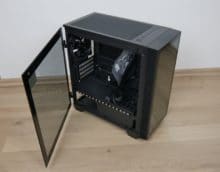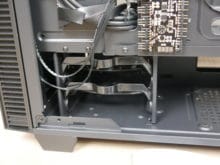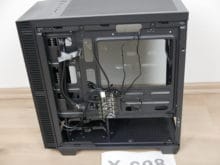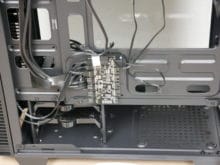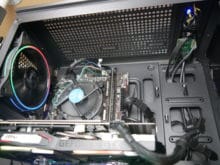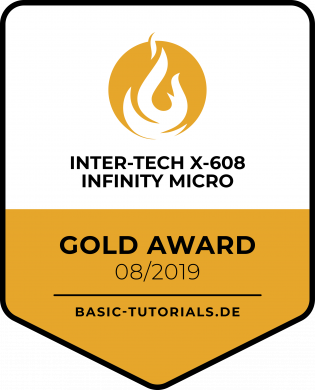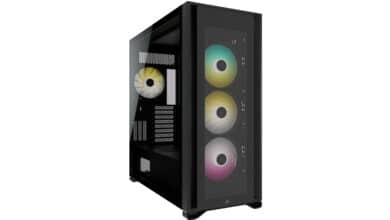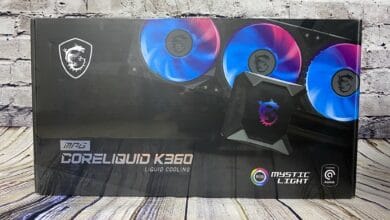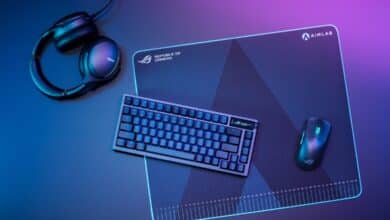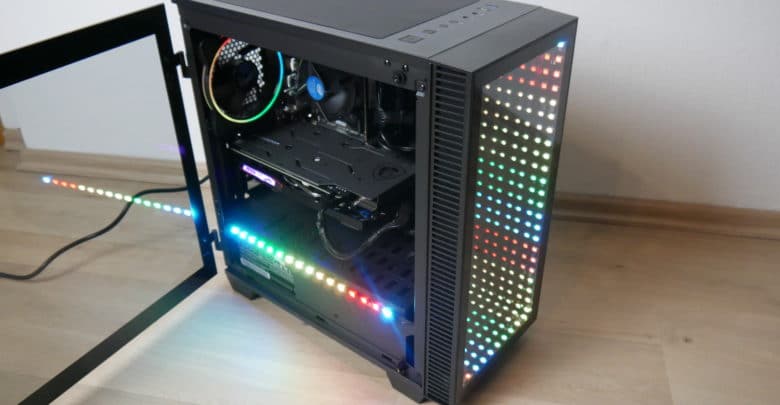
With the X-608 Infinity Micro, Inter-Tech has added a little brother to the big X-908 Infini2. After we’ve already taken a look at the X-908 Infini2, let’s take a closer look at the X-608. First to the technical details.
| Model | X-608 Infinity Micro |
| Housing type | Gaming Tower |
| Dimensions | 195 mm (W) x 415 mm (H) x 405 mm (D) |
| Weight | Ca. 5.84 kg |
| Material | Steel, Plastic, Tempered Glass |
| Color | Black |
| Front connections | 1x USB 3.0, 1x USB 3.0 Type C, 1x Microphone, 1x Headphone |
| Drive bays | 2x 3.5″ (internal)*
5x 2,5″ (internal)* |
| Extension slots | 4 (horizontal) |
| Form factors | µATX, ITX |
| Ventilation | Front: 3x 120 mm (optional)
Cover: 2x 120 mm (optional) Rear: 1x 120 mm (standard RGB 3pin) |
| Radiators | Front: 120/240/360 mm
Cover: 120/240 mm Back side: 120 mm |
| Max. CPU cooler height | 150 mm |
| Max. Graphics card length | 320 mm |
| Power supply unit | ATX |
| Price | € 69.81 * |
| Special features | dust filter, addressable RGB fans, tempered glass, decoupled power supply mount |
Packaging and Scope of Delivery
The Inter-Tech X-608 Infinity Micro is just as well packed as its big brother. Wrapped by two polystyrene plates, the case is well protected against shocks during transport. All accessories are packed in a plastic bag. The bag contains a manual as well as all necessary screws including some spare screws. There are also some cable ties, a graphics card holder and a Rainbow Sync cable. An addressable RGB fan from the Argus series and an RGB/PWM fan controller for up to five RGB devices and five 3-pin fans are pre-installed directly.
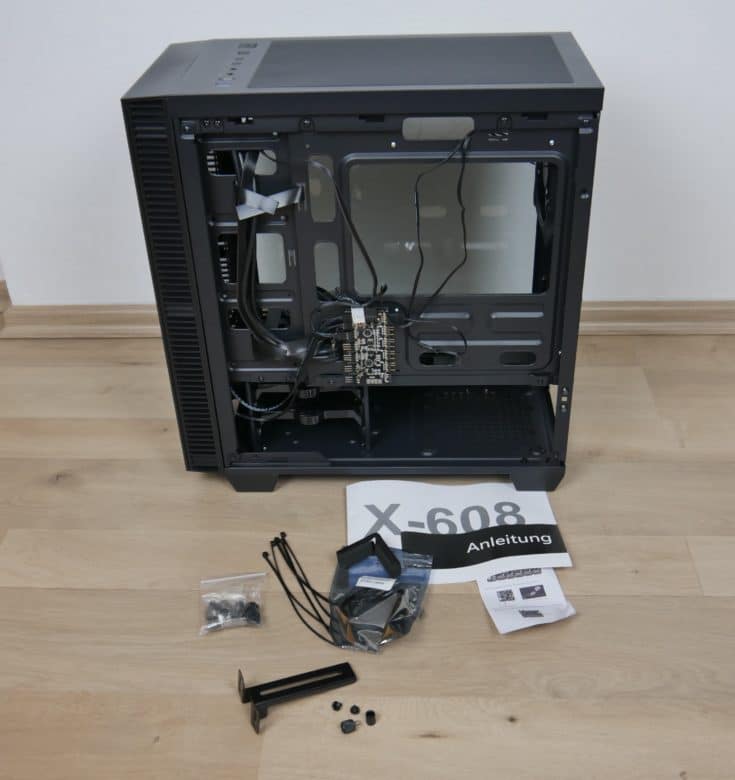

Exterior impression
As soon as you unpack it, you feel that there is nothing to criticise about the quality and the workmanship.
In addition to the different sizes of the two brothers, it should also be noted that the front in the X-608 is mounted without screws and the large tempered glass side window is only fixed with two screws. At the back, the viewing window is fixed with two hinges, so that it can be easily opened.
The front panel has shrunk a bit in comparison. Instead of two USB 3.0 type A and two USB 3.0 type C ports each, only one port is available. There is also a headphone and microphone port. The RGB lighting is controlled with two additional buttons. With the left button the brightness can be adjusted in four steps and with the right button the preset effects can be switched through.
On the top of the X-608 there is also a fine mesh grid that serves as a dust filter and is magnetically held in place. So it can be easily removed and cleaned at any time.
Internal impression
The interior of the Inter-Tech X-608 Infinity Micro is clearly divided into two areas by the power supply cover. As usual, the mainboard tray and the power supply tunnel are provided with some openings for cable management. Unfortunately, they decided against rubber sleeves here as well.
Up to four expansion cards can be screwed inside the case. All slot bezels are reusable, so that an exchange or removal does not leave any unattractive holes.
A view of the rear side reveals the RGB/PWM control as well as the already connected cables to the front panel and the fans. At first glance, everything looks full of cables and relatively cramped.
Two 3.5″ hard disks or five 2.5″ hard disks with a plastic frame can also be installed in the front under the power supply tunnel.
System configuration in the X-608 Infinity Micro
Now we come to the installation of the components. As processor we use a Intel Core-i3-8100* on the B360 Pro-VH* from MSI with 8 Gigabyte G.Skill Aegis DDR4-2133 RAM*. The graphics card is a GTX 1660 Ti Gaming 6G* from MSI and the 400W Pure Power 10* from be quiet! provides the necessary performance.
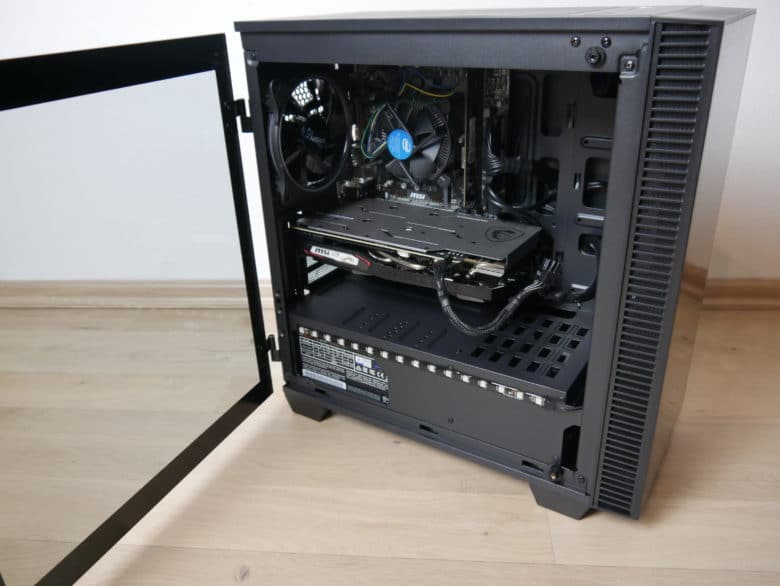
The installation of the components ran without problems. All screws are available and all necessary spacers can be added.
In contrast to the wiring of the same system in the big brother, the cable length fits perfectly for Micro-ATX systems. There are hardly any superfluous cables in the interior and you can also make it look nice. The only disadvantage is that the remaining cables have to be accommodated without a partially or fully modular power supply. Here you have to be creative due to the limited space.
Lighting, cooling power and volume
The highlight of the case of the smaller X-608 is of course also the Infinity front. The mirror front comes across even better than its big brother. And similar to the X-908, the power supply tunnel is also illuminated with an RGB LED strip. The RGB controller is compatible with various programs such as Aura Sync, RGB Fusion, Mystic Light Sync and Polychrome. So the housing lighting can be synchronized with the rest of the hardware via the mainboard.
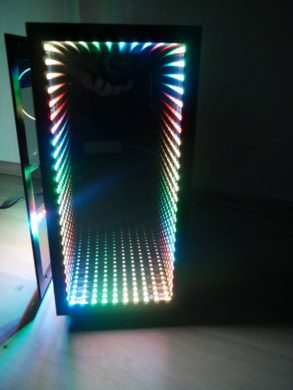
To get a short impression of the cooling performance, we loaded the system described above with Prime95 and FurMark for 15 minutes. The case fan runs at a speed of 1400 RPM and is audible, but not disturbing.
| Condition | Temperature |
|---|---|
| Idle | CPU: 35°C GPU: 46°C |
| Load | CPU: 73°C GPU: 70°C |
The temperature in the small case is anything but alarming, especially when you consider that only one case fan is installed in the whole system. This is sufficient for normal operation and can be extended as needed.
Conclusion of the Inter-Tech X-608 Infinity Micro Test
Let’s just put it all together. The Inter-Tech X-608 Infinity Micro comes with a really good RGB lighting. This can be addressed and synchronized via various programs. The workmanship leaves nothing to be desired. The extras, such as the dust filter and the addressable RGB fan, offer everything you need and leave nothing to be desired.
All in all, Inter-Tech offers a small but spacious and well thought-out housing. It can be used in a variety of ways, even if unfortunately not everything has been perfectly implemented. The price-performance ratio is not the best, but with the Infinity front you get something unique.
Inter-Tech X-608 Infinity Micro
Workmanship
Structure
Features
Cooling
Value for Money
Very good and compact housing with many extras.




